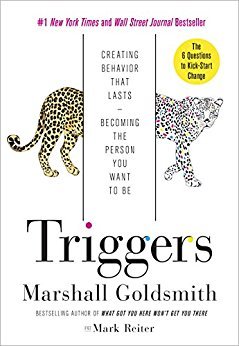More on this book
Community
Kindle Notes & Highlights
Read between
October 9 - October 14, 2020
External triggers come from the environment, bombarding our five senses as well as our minds.
Internal triggers come from thoughts or feelings that are not connected with any outside stimulus.
Conscious triggers require awareness.
Unconscious triggers shape your behavior beyond your awareness.
A trigger can be anticipated or unexpected.
Encouraging triggers push us to maintain or expand what we are doing. They are reinforcing.
Discouraging triggers push us to stop or reduce what we are doing.
6. A trigger can be productive or counterproductive.
Productive triggers push us toward becoming the person we want to be. Counterproductive triggers pull us away.
encouraging triggers lead us toward what we want and productive triggers lead us toward what we need.
an appealing distraction can trigger a self-defeating choice.
when it comes to our behavior, we always have a choice.
cue, routine, and reward to describe the three-part sequence known as a habit loop.
Duhigg’s Golden Rule of Habit Change—keep the cue and reward, change the routine—but
The habit loop makes it sound as if all we need is an awareness of our cues so we can automatically respond with an appropriate behavior.
when we’re changing interpersonal behavior, we’re adding a layer of complexity in the form of other people.
With people in the mix, mere habit can’t guide our behavior. We must be adaptable, not habitual—because the stakes are so much higher.
If we’re paying attention (and being on national TV will increase anyone’s level of awareness), this is how triggers work.
we don’t yield to impulse. We reflect, choose, then respond.
The most effective leaders can vary their leadership style to fit the needs of the situation. Hence, the term situational leadership.
Directing is for employees requiring a lot of specific guidance to complete the task.
It’s primarily a one-way conversation, with little input from the employee.
Coaching is for employees who need more than average guidance to complete the task, but with above-average amounts of two-way dialogue. Coaching is for people who both want and need to learn.
Supporting is for employees with the skills to complete the task but who may lack the confidence to do it on their own. This style features below-average amounts of direction.
Delegating is for employees who score high on motivation, ability, and confidence. They know what to do, how to do it, and can do it on their own.
how we manage others is how we should manage ourselves—with
We are superior planners and inferior doers.
Forecasting is what we must do after acknowledging the environment’s power over us. It comprises three interconnected stages: anticipation, avoidance, and adjustment.
When our performance has clear and immediate consequences, we rise to the occasion. We create our environment. We don’t let it re-create us.
Quite often our smartest response to an environment is avoiding it.
On the other hand, we rarely triumph over an environment that is enjoyable. We’d rather continue enjoying it than abandon or avoid it.
impulse to always engage rather than selectively avoid
To avoid undesirable behavior, avoid the environments where it is most likely to occur.
Adjustment, if we’re lucky, is the end product of forecasting—but only after we anticipate our environment’s impact and eliminate avoidance as an option.
there is no harder task for adults than changing our behavior.
One of our greatest instances of denial involves our relationship with our environment.
in pursuing any behavioral change we have four options: change or keep the positive elements, change or keep the negative.
• Creating represents the positive elements that we want to create in our future. • Preserving represents the positive elements that we want to keep in the future. • Eliminating represents the negative elements that we want to eliminate in the future. • Accepting represents the negative elements that we need to accept in the future.
The challenge is to do it by choice, not as a bystander. Are we creating ourselves, or wasting the opportunity and being created by external forces instead?
Preserving sounds passive and mundane, but it’s a real choice. It requires soul-searching to figure out what serves us well, and discipline to refrain from abandoning it for something new and shiny and not necessarily better.
“What in my life is worth keeping?”
our natural impulse is to think wishfully (that is, favor the optimal, discount the negative) rather than realistically.
Accepting is most valuable when we are powerless to make a difference.
our episodes of nonacceptance trigger more bad behavior than the fallout from our creating, preserving, and eliminating combined.
Good things happen when we ask ourselves what we need to create, preserve, eliminate, and accept—a
When asked exclusively, passive questions can be the natural enemy of taking personal responsibility and demonstrating accountability.
People don’t get better without follow-up. So let’s get better at following up with our people.


